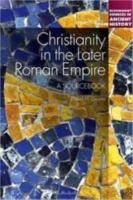
Bloomsbury (2015) p/b 293pp £22.99 (ISBN 9781441106261)
Rather than a ‘sourcebook’, this might best be described as a comprehensive introductory overview of this complex and confusing subject. As such, it is an excellent way in; the serious student will want to go deeper.
The book is divided into themed chapters: in each chapter, the points made are illustrated with quotations, sometimes lengthy, from the sources being discussed, set out in a boxed format which separates them from the narrative. This is a useful device, although it forces the reader to make choices: should one read the story first, ignoring the quotations, and go back to them later, or is it better to read straight through at the risk of the quotations breaking one’s concentration on the story?
The themes covered include: the early history of the new faith in the pagan empire up to the conversion of Constantine and its establishment as the imperial Church; the first heresies (Donatism, Arius, Mani) and the development of the doctrine of the Trinity; the later controversies over the nature of Christ; Church structure (scripture and liturgy, the hierarchy and Episcopal authority, asceticism and monasticism, saints, pilgrimages and relics, missionaries); interaction with the classical world (the refashioning of pagan customs, education and culture, the perception of women); relationship with Jews and condemnation of Manichees; and finally, how Christianity survived the dissolution of the Western Empire through the conversion of barbarian invaders, the preservation of Catholicism by the Franks, and the emergence of the pope as the only possible monarchical authority over the West.
This is an immense area to cover in a not very big book, and G. deserves great credit for making it comprehensible and easy to read, even when he is getting to grips with the christological controversies and the various Church Councils. Inevitably there are some gaps. While Augustine gets good coverage (indeed a chapter to himself), one would have liked a bit more on some of the other Fathers of the Church; Origen and the controversies that surrounded him are hardly mentioned at all. But this is a minor cavil. Anyone studying this period for the first time will find this a most useful book.
There are maps, a chronological table of key dates, an index of texts cited and a general index, and each chapter ends with its own bibliography for further reading.
Colin McDonald
